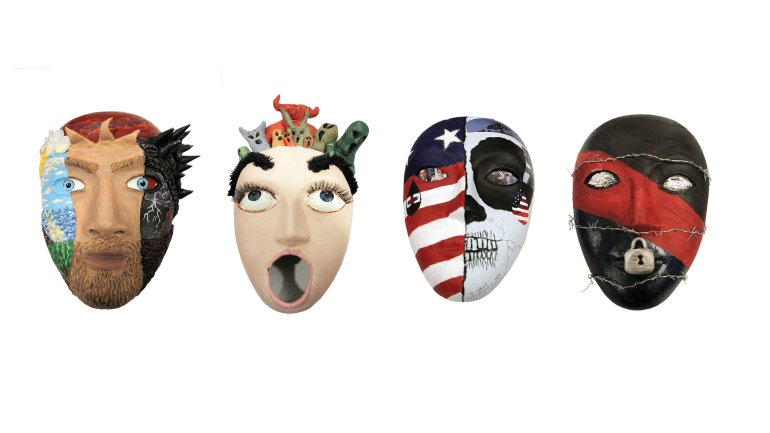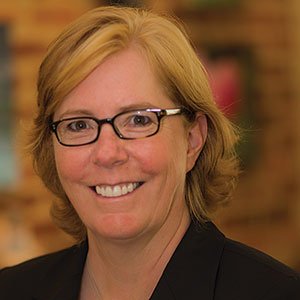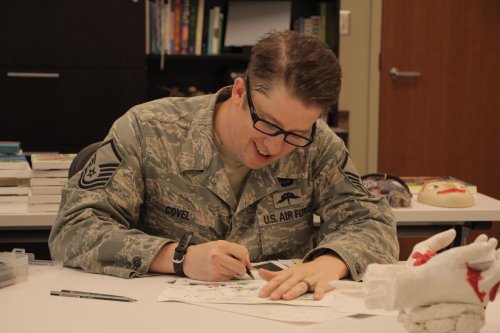Arts in Service
Arts in Service
Sara Kass is a doctor and a retired Navy captain – she’s not really an arts person. But in the last six years, she’s discovered for herself the power of the arts. Starting in 2011, she was the medical director for the Department of Defense’s traumatic brain injury and post-traumatic stress research center in Bethesda, Maryland. As patients there concluded treatment, they were asked to identify the five most valuable activities and disciplines out of the 40 they encountered in treatment – from nutrition to psychiatry to neurology. The answers were striking: “They always ranked creative arts therapies as one of the top five,” Kass recalls. “And they also ranked it as one of the top five things that they wanted to continue when they left, to maintain their wellness.”
Not only were patients’ creative activities – painting, maskmaking, sculpture, writing, dance, music – powerfully therapeutic, but they were also cheap. Operating the arts therapy program consumed less than 1 percent of Kass’ budget. It was, she says, “a very effective and cost-effective intervention to help with these very complex injuries.”
Today, Kass is the military and medical adviser for Creative Forces, a joint program of the Department of Defense, the National Endowment for the Arts, and the Department of Veterans Affairs. Thanks to a 2016 congressional appropriation of $2 million, creative arts therapies are now integral to treatment for active-duty military members with traumatic brain injuries and PTSD at 11 Creative Forces sites around the country. Each year, more than 12,000 people and their families will be served through the program, Kass estimates.
In today’s world, the arts can seem extraneous, their impact negligible. Yet they’ve been proven to be potent treatments for devastating injuries suffered by some of the toughest people around. We asked Kass to tell us how the arts transform lives.
What sorts of creative arts do patients work with in Creative Forces programs?
There’s writing, dance/movement, music, and visual art. But it’s important to emphasize that the making of music and the creation of art and the dancing and the writing are all part of very specific therapeutic interventions. It’s not just, “Let’s invite you into this room and let you pull out some paints and play with paint.” It’s a professionally trained art or music or movement therapist who understands the condition of the patient and specifically applies different arts activities to help them to address their condition.
What art mediums do they use when they make visual art?
There are a number of different options, from painting to maskmaking to sculpture and woodburning. And there are pro--grams that we engage with that do iron forging and glass- blowing. There are some on our team who do fly-tying, for fly fishing. Almost any art form and medium has the potential to be therapeutic in the hands of a trained therapist.
Art activities have been around the military for a while, of course. The founder of the ACC, Aileen Osborn Webb, was an early advocate for the benefits of basketweaving and other craft activities, which her brother, an Army general, helped to incorporate into military life in the early 1940s.
Wow, interesting. Both music therapy and art therapy have been around for quite a while; music therapy has roots in World War II, when music was brought in to soothe the nerves of people suffering from what was called “battle fatigue.”
And it has grown. At Creative Forces, we try to emphasize the value of both these very intentional creative arts therapies, as well as continued engagement with arts as recreation for life. It’s such an important way to continue to maintain health and wellness and personal well-being.
It sounds like you’re saying that creative activities are a part of a healthy life.
Absolutely.
OK – you heard it here.
You heard it here.
You’re a physician. When you size up the human animal, why do you say creative activities are essential to a healthy life?
It’s healthy in so many different ways – just a calming of the mind and a chance to relax and reset and kind of lose yourself in a project so that all those other stressors that we deal with, day in and day out, sort of fade to the fringe. But part of what happens when one is doing that is that it also opens up their brain to work more effectively. Creativity allows us to solve problems and address the challenges that we face in a unique way, in a different way from the mainstream way of thinking about things. Engagement in art helps us to relax, but the firing of your creative muscle allows you to then exercise it more effectively, in facing challenges and dealing with problems. That’s what is so critical about it.
And, with the guidance and engagement of a therapist, the creative process also allows people to really unpackage and process and deal with traumas that they’ve experienced.
So when service members come to the attention of Creative Forces because of traumatic brain injuries or PTSD, what happens next? How are they funneled into a creative activity?
When they’re referred for treatment in one of these centers, simultaneous to that, synonymous with that, they are referred to creative arts therapies. They are evaluated by a creative arts therapist who may see them, initially in a group setting, and then will identify both group projects they can work on that will be helpful as well as possible individualized treatment and engagement. It varies depending on the need of the individual, but all patients are seen by the creative arts therapists to be assessed and figure out what treatments might be helpful.
It’s easy for us civilians to think of military people as stereotypically masculine and stoic and not emotionally needy. Obviously, that’s false; they’re human beings. But why is it that art activities or dance or music seem particularly therapeutic for people in the service?
There are two important reasons. First, another characterization of the military population is that they are innovative problem solvers. When you’re thrown into a field environment and you’ve got to get your job done, you are creative, and you solve problems. They embrace this idea of innovative solutions. So they’re open-minded, and they’re willing to try things.
Second, when patients enter into integrated care, oftentimes, there’s this focus on what they’re no longer able to do, their disabilities. But when you get into the creative process, you start to discover what your abilities are. There’s a focus on the positive, skill-building side.
Also, in most of the environments where Creative Forces has a footprint, the minute they walk into a center, people see the product of creative arts therapies on the walls. They see that others before them have given this a try. They tend to be very open to saying, “OK, if this works for others, then I’m going to try it, too.” They engage.
Creative therapy can calm people, and it can also help people sort through the most difficult, stressful feelings. Are there other potential benefits?
Patients can learn emotional regulation – to take what you’re feeling and find a healthy way to express it. For some people, it becomes something they continue as a hobby as they leave. For others, it becomes a way to transition, to start to think, “Maybe this is what I want to do next in my life.”
What can creative therapy do that talk therapy can’t?
In traditional therapy, it’s an individual sitting down in a room, with the therapist across the room, saying, “Tell me what’s going on, and how are you feeling?” This requirement to verbally relay what it is that you’ve been struggling with can be really challenging. And sometimes there may be physical limitations that just don’t allow you to access that part of your brain, to really express what’s going on.
When a person sits down and goes through a creative process – whether that might be song-writing or thinking through dance choreography or making a mask, painting a painting – they access that other part of the brain that is more artistic.
And whether verbally, in writing, or in a nonverbal way, they are able to tell a story, control the narrative of what happened to them or what they’re processing, what they’re struggling with. That allows them to externalize it, hold it out, away from themselves, and then be able to talk about it in a more effective way with the therapist.
I’ve had this idea that maybe some patients have performance anxiety, like “I don’t know how to sing” or “I can’t paint”– that they would worry about doing it right. But it sounds like, with the therapist’s guidance, that’s not really an issue.
I’m not going to say nobody has any anxiety about it. But I think that they’re guided through that in a very nurturing, supportive way. This comes back to having a skilled therapist, because the process of sitting down and saying, “OK, create art” would be very daunting.
Instead, a therapist sits with somebody and meets them where they are and understands everybody’s a little bit different, and then reiterates to them that this isn’t about what you create, it’s about the process of creation. You’re not going to be judged on this; it is about [finding] a way for you to express yourself.
Do you feel that, in general, the art process, the creative process, is undervalued?
I’m a newbie to the art community. It’s not where I necessarily live. But I suspect it’s one of those things that doesn’t get as much attention as other things. And I think that for every artist who makes a million dollars on something, there are a million artists who are not even making a buck; they’re spending money.
It’s undervalued, perhaps, by society, but I don’t think it’s undervalued by the people who are engaging in the practice. Because I think for the individual who is engaging in the practice, they know for themselves what the value of that practice is and that sense of pride in their own art, even if nobody else ever buys it. The people who do it appreciate the process.
Tell us about people who’ve used creative therapies as a springboard to a new vocation.
There’s one patient who continued to engage in the arts as he left here and realized there were others who were doing it as well, and wanted to create a venue for military people who were engaging in arts for their health, a place where they could show their art and, potentially, even sell it. And so Rusty Noesner started a nonprofit called War Paints. That’s not a patient confidentiality issue, because he’s all over the place.
There’s another young woman who found the creative arts therapies to be very helpful and wanted to continue painting after she left here. And she ended up moving back to a rural location and opened up a studio for people to come in and create art, because there was nothing in the rural town where she was. So she went ahead and created this studio.
We have another guy who’s out [of the program], loved music therapy, decided to explore other ways to be creative, and is now selling the leather goods that he’s crafting. There are lots of stories.
I have to ask: There’s been a lot of talk about cutting NEA funding, which is what made the recent Creative Forces expansion possible. Are you worried?
We’re not doing anything differently now than we were before. We charge on and do what we’ve got to do, because there are people who need to be served.
We have ways we can grow and serve even more people in the years to come, and we plan to continue to do just that.
Are you saying there’s hope for even further expansion?
Yes, ma’am. We’re doing research, and we are working on toolkits and manuals that will help people to implement this kind of a program wherever they are. And we intend to be there, helping them as they do that.
What’s it like for you to see the successes – as a physician, as a military person?
I love it. It’s changing lives. As a veteran myself, this is very personal for me, to see that we make programs like this accessible to even more people who are suffering.
And when I see any of the hundreds of stories of people whose lives have been changed by what creative arts therapy brings, it leaves me with two feelings: One, an enormous sense of pride in what we’re accomplishing; but also an enormous sense of urgency, because there are so many more people who need these services.




